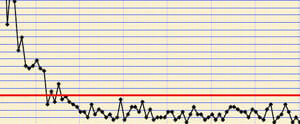Radon Health Risks
Risk Assessment
The EPA has identified radon exposure as the #1 cause of lung cancer in non-smokers, second only to cigarette smoking. The level of risk associated with elevated radon concentrations are considered to be linear, meaning higher levels and longer duration of exposure increase risk accordingly to the increase in concentration and amount of time exposed. As a smoker, your risk of lung cancer is estimated to be approximately 10X higher than that of a non-smoker when exposed to similar concentrations of radon.
The US EPA's action level for Radon is 4.0 pCi/L. The World Health Organization recommends that homeowners take action to remediate the radon level in their home if it exceeds 2.7 pCi/L, 33% lower than the current EPA action level.
Health Effects of Exposure
![]()
Lung Cancer
Radon is the #1 cause of lung cancer for non-smokers and the 2nd leading cause of lung cancer in the U.S.
![]()
High Toxicity
According to the EPA, Radon carries 1,000 times the risk of death as any other EPA carcinogen.
![]()
Higher Risk for Children
Due to their higher respiratory rates and smaller lung size, children are at greater risk of radon induced lung cancer. Children are at a 20x higher risk of developing lung cancer when exposed to Radon and cigarette smoke than adults.
![]()
Annual Deaths
The EPA estimates that 21,000 people die each year in the US from lung cancer caused by Radon exposure.
![]()
Rapid Death Toll
Radon kills one person every 25 minutes.
EPA risk assessment data from radon exposure is based on a lifetime of exposure.
- Not everyone exposed to even high levels of radon will contract radon induced lung cancer.
- All radon levels can be lowered, which lowers the risk assessment.
Lung cancer incidence from radon exposure is so prevalent that risk assessment is stated in terms of one in 1,000. Other environmental exposures are stated in measurements of one in 100,000.
Does radon cause other health problems or symptoms?
There have not been any scientific studies linking Radon Gas exposure to any other cancers.
Radon Risk If You Smoke
| Radon Level | If 1,000 people who smoked were exposed to this level over a lifetime* |
The risk of cancer from radon exposure compares to** |
WHAT TO DO: Stop smoking and... |
| 20 pCi/L | About 260 people could get lung cancer | 250 times the risk of drowning | Fix your home |
| 10 pCi/L | About 150 people could get lung cancer | 200 times the risk of dying in a home fire | Fix your home |
| 8 pCi/L | About 120 people could get lung cancer | 30 times the risk of dying in a fall | Fix your home |
| 4 pCi/L | About 62 people could get lung cancer | 5 times the risk of dying in a car crash | Fix your home |
| 2 pCi/L | About 32 people could get lung cancer | 6 times the risk of dying from poison | Consider fixing between 2 and 4 pCi/L |
| 1.3 pCi/L | About 20 people could get lung cancer | (Average indoor radon level) | (Reducing radon levels below 2 pCi/L is difficult.) |
| 0.4 pCi/L | About 3 people could get lung cancer | (Average outdoor radon level) | (Reducing radon levels below 2 pCi/L is difficult.) |
| Note: If you are a former smoker, your risk may be lower. pCi/L (pico Curies per Liter) * Lifetime risk of lung cancer deaths from EPA Assessment of Risks from Radon in Homes (EPA 402-R-03-003). ** Comparison data calculated using the Centers for Disease Control and Prevention's 1999-2001 National Center for Injury Prevention and Control Reports. |
|||
Radon Risk If You've Never Smoked
| Radon Level | If 1,000 people who have never smoked were exposed to this level over a lifetime* | The risk of cancer from radon exposure compares to** |
WHAT TO DO: Stop smoking and... |
| 20 pCi/L | About 36 people could get lung cancer | 35 times the risk of drowning | Fix your home |
| 10 pCi/L | About 18 people could get lung cancer | 20 times the risk of dying in a home fire | Fix your home |
| 8 pCi/L | About 15 people could get lung cancer | 4 times the risk of dying in a fall | Fix your home |
| 4 pCi/L | About 7 people could get lung cancer | The risk of dying in a car crash | Fix your home |
| 2 pCi/L | About 4 people could get lung cancer | The risk of dying from poison | Consider fixing between 2 and 4 pCi/L |
| 1.3 pCi/L | About 2 people could get lung cancer | (Average indoor radon level) | (Reducing radon levels below 2 pCi/L is difficult.) |
| 0.4 pCi/L | (Average outdoor radon level) | (Reducing radon levels below 2 pCi/L is difficult.) | |
| Note: If you are a former smoker, your risk may be higher. pCi/L (pico Curies per Liter) * Lifetime risk of lung cancer deaths from EPA Assessment of Risks from Radon in Homes (EPA 402-R-03-003). ** Comparison data calculated using the Centers for Disease Control and Prevention's 1999-2001 National Center for Injury Prevention and Control Reports. |
|||




